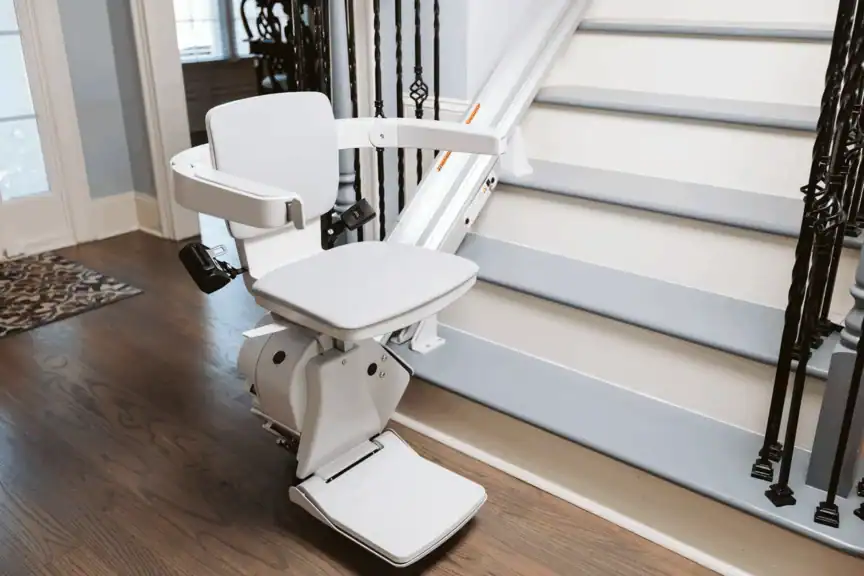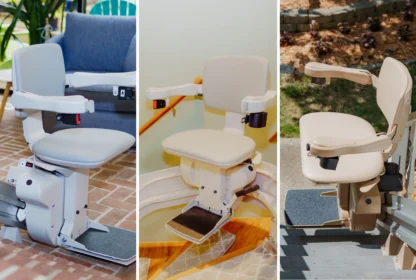
Parkinson’s disease is the fastest growing neurodegenerative disease in the world, and the second most common after Alzheimer’s disease. With an estimated 1 million people in the U.S. living with PD and more than 10 million people worldwide, according to the American Parkinson’s Disease Association (APDA), the condition presents unique challenges to daily living. Common symptoms like bradykinesia, tremors, postural instability, and freezing episodes can make once-familiar spaces feel like an obstacle course. Falls, which are already a risk for many aging in place, often become more common as Parkinson’s progresses.
At 101 Mobility, we know remaining in your home creates comfort, but to enjoy your home, you may have to make adaptations. This guide highlights room-by-room guidance for creating a safer, more accessible, and comfortable living environment for those living with Parkinson’s disease.
Understanding the Key Challenges of Parkinson’s at Home
Because Parkinson’s is a type of neurologic movement disorder, many of the symptoms affect movement or fine motor skills. The most common — and well known — symptom is a persistent tremor, but Parkinson’s patients experience a wide range of symptoms including:
- Bradykinesia (Slowness of Movement): Difficulty initiating movement, navigating tight spaces. Additionally, bradykinesia can cause problems with fine motor coordination or cause difficulties turning over in bed.
- Tremors and Dyskinesia: About 80% of people with Parkinson’s experience tremors, according to the APDA. These tremors, particularly the “pill rolling” motion in hands, can make daily tasks like cooking, buttoning clothes, and household chores a challenge.
- Postural Instability & “Freezing”: Postural instability includes the inability to maintain a steady, upright posture or to prevent a fall. When combined with the involuntary inability to move, referred to as “freezing,” those in the later stages of Parkinson’s are at risk without mobility assistance in walkways, stairs, or doorways.
- Gait & Walking Difficulties: About 38% of people living with Parkinson’s fall each year. This is, in part, due to the common changes to gait. A common, early symptom of Parkinson’s disease is a decrease in the natural swing of one or both arms when walking. This creates an unbalanced gait pattern that is more susceptible to tripping and falls in doorways or on stairs. As Parkinson’s progresses, people can experience slow, shuffling steps or an involuntary and uncontrolled acceleration. Uneven surfaces like doorjams, rugs, or stairs can also be problematic.
- Fatigue: According to the APDA, when people with Parkinson’s are asked about fatigue, they use phrases such as, “I feel run down, I am out of energy, or I am unable to do anything.” A home needs to have strategically placed resting areas and energy-conserving solutions.
General Home Safety Modifications: The First Steps

Living with Parkinson’s shouldn’t mean you have to leave your home. Before diving into room-specific changes, there are several broad modifications you can make across the entire home that will significantly boost safety and reduce the risk of falls for someone with Parkinson’s.
- Optimize Lighting: Install bright, even lighting throughout the home to eliminate shadows and improve visibility. Place nightlights in key areas like hallways, bedrooms, and bathrooms for safe nighttime movement.
- Clear Clutter & Tripping Hazards: Clear pathways of all unnecessary items, hide electrical cords, and reduce unnecessary furniture to create wider, easier-to-navigate routes. Remove throw rugs completely, or ensure they are securely fastened to the floor to prevent edges from lifting and causing a trip.
- Consider Flooring: The floor surface itself can be a major challenge for the “freezing” episodes common with Parkinson’s. The best choice is often low-pile carpet or non-slip hard surfaces (like non-glossy tile or wood). Avoid highly polished floors, deep-pile carpets, or rugs with busy patterns that can make the floor plane confusing to the eye.
- Utilize Smart Home Technology: Consider installing automatic door openers or hands-free lighting controls to eliminate the need for fine motor skills or struggling to initiate movement in tight spaces.
Room-by-Room Modifications for Parkinson’s Safety
Navigating the home with Parkinson’s requires specific adaptations. Below, you will find a room-by-room breakdown of the major challenges posed by Parkinson’s symptoms and the practical, actionable solutions for creating a safer environment.
The Bathroom: Prioritizing Fall Prevention

The bathroom is one of the most dangerous areas in the home due to slippery surfaces and the confined spaces that can trigger “freezing”.
- Challenges: Slippery surfaces, difficulty getting in and out of the tub, and using the toilet.
- Solutions:
- Install grab bars near the toilet and inside the shower/tub area for secure support during transitions.
- Use a non-slip bath mat and consider a shower transfer chair to allow for seated bathing, conserving energy and reducing the risk of a slip while standing.
- Consider a raised toilet seat to make sitting down and standing up easier.
- For a comprehensive solution that eliminates stepping over a high ledge, consider a barrier-free shower or a custom whole-bathroom renovation.
The Bedroom: Ensuring Safe Rest and Movement
Safety in the bedroom is essential, especially when navigating the room during the night.
- Challenges: Getting in and out of bed, and navigating the room in the dark.
- Solutions:
- Install a bed rail or assist handle on the side of the bed for support when changing positions or standing up.
- Ensure there is a clear path from the bed to the door, removing any bedside tables or floor lamps that could pose a hazard.
- Place a sturdy chair in the room to assist with dressing, which is a task requiring fine motor skills that can be challenging due to tremors.
- Keep a lamp or phone within easy reach of the bed.
The Kitchen: Adapting for Independence
The kitchen should be organized to minimize the need for awkward movements and reduce the risk of handling hot items while managing tremors.
- Challenges: Reaching high or low cabinets, handling hot items, and standing for long periods.
- Solutions:
- Organize cabinets to keep frequently used items at waist level, reducing the need to bend, reach, or overextend.
- Use lightweight cookware and adaptive utensils designed for reduced grip strength or tremors.
- Ensure the kitchen is well-lit, especially over preparation areas.
- Place a stool or chair nearby for seated tasks like food preparation or washing dishes, helping to manage fatigue.
Stairways and Entryways: Ensuring Safe Transitions
Stairs are a major fall hazard, and thresholds at entryways can trigger freezing or tripping.
- Challenges: Stairs are a major fall hazard; thresholds can cause tripping.
- Solutions:
- Install sturdy handrails on both sides of all staircases.
- Ensure stairs are well-lit and have non-slip treads.
- Consider stairlifts as the safest and most effective solution. These devices work by securely transporting the individual up and down the staircase while seated, providing complete independence and eliminating the significant fall risk associated with stairs.
- For entryways with steps, wheelchair ramps or platform lifts help create barrier-free access and ease the transition into and out of the home.
When to Seek Professional Help: Consulting an Expert

Creating a Parkinson’s-friendly home is often a collaborative effort. Consulting professionals can ensure that modifications are personalized, correctly implemented, and meet all safety standards.
Occupational Therapists (OTs): Your physician may have recommendations for professionals who can assess your home environment. Professionals like OTs can perform a comprehensive home safety evaluation. They are specialists who can assess an individual’s specific symptoms and needs, and recommend personalized modifications and adaptive equipment.
Certified Accessibility Specialists: Experts like the specialists at 101 Mobility are vital for handling the installation of complex mobility equipment. Our trained technicians can assess your home and professionally install equipment like stairlifts, ramps, and grab bars to ensure they are secure and meet all safety standards.
During a no-pressure consultation, our team will:
- Conduct a comprehensive home safety review tailored to your goals.
- Recommend personalized solutions that address your specific mobility challenges.
- Explain each product in plain language so you can make confident choices.
- Offer flexible service and rental options for both temporary and long-term needs.
If you’re ready to take the next step toward a safer, more accessible home, schedule a free in-home consultation today.
Frequently Asked Questions
How do you make a house safe for someone with Parkinson’s?
The best way to improve safety is to minimize fall hazards. This includes improving lighting, removing throw rugs and clutter, installing safety devices like grab bars, and addressing stairs with solutions like stairlifts. These modifications support independence and provide a safer, easier-to-navigate environment.
What is the best flooring for Parkinson’s patients?
The best flooring is generally non-slip, low-pile carpet or low-gloss hard flooring. These surfaces help reduce the risk of tripping and minimize visual confusion, which can trigger “freezing” episodes. Avoid deep-pile carpets, busy patterns, and highly polished surfaces.
How can I help someone with Parkinson’s in the bathroom?
Focus on addressing the challenges of slippery surfaces and confined spaces. You can help by installing grab bars near the toilet and shower, and using a shower chair or transfer bench. These solutions minimize the need for strenuous standing and movement on wet surfaces, reducing fall risk.
Are stairlifts a good idea for Parkinson’s patients?
Yes, stairlifts are often considered the safest and most effective solution for individuals with mobility issues, including Parkinson’s, in multi-level homes. They eliminate the major fall risk associated with climbing stairs, which is crucial due to postural instability and freezing. Using a stairlift preserves energy and enhances independence.



